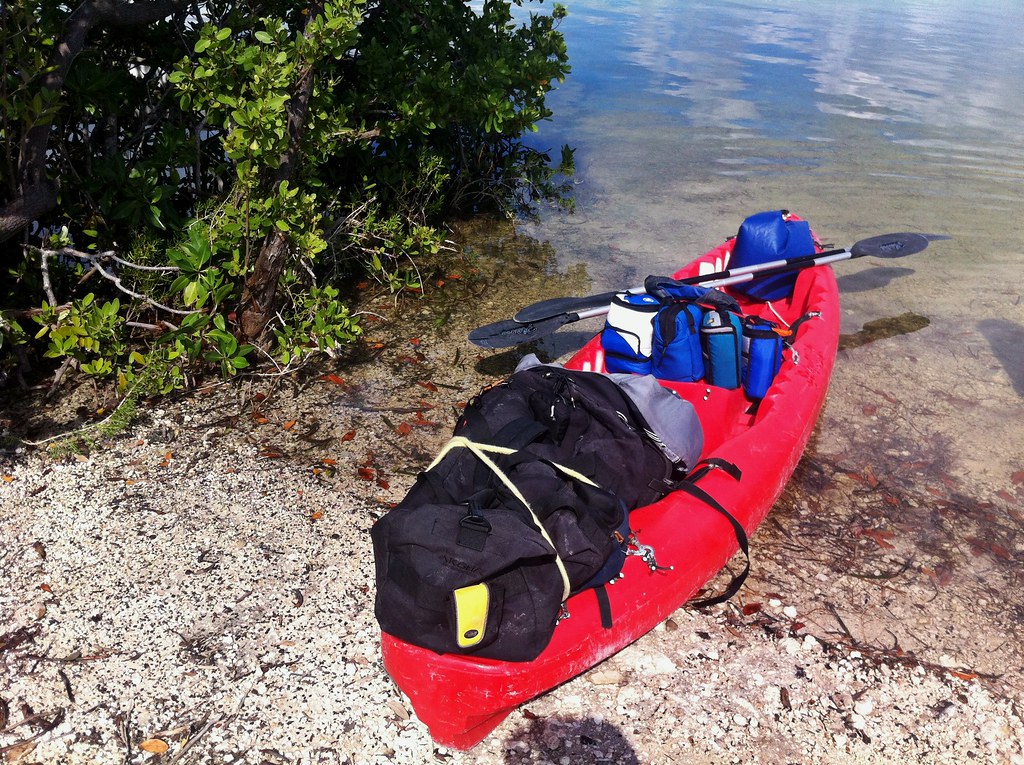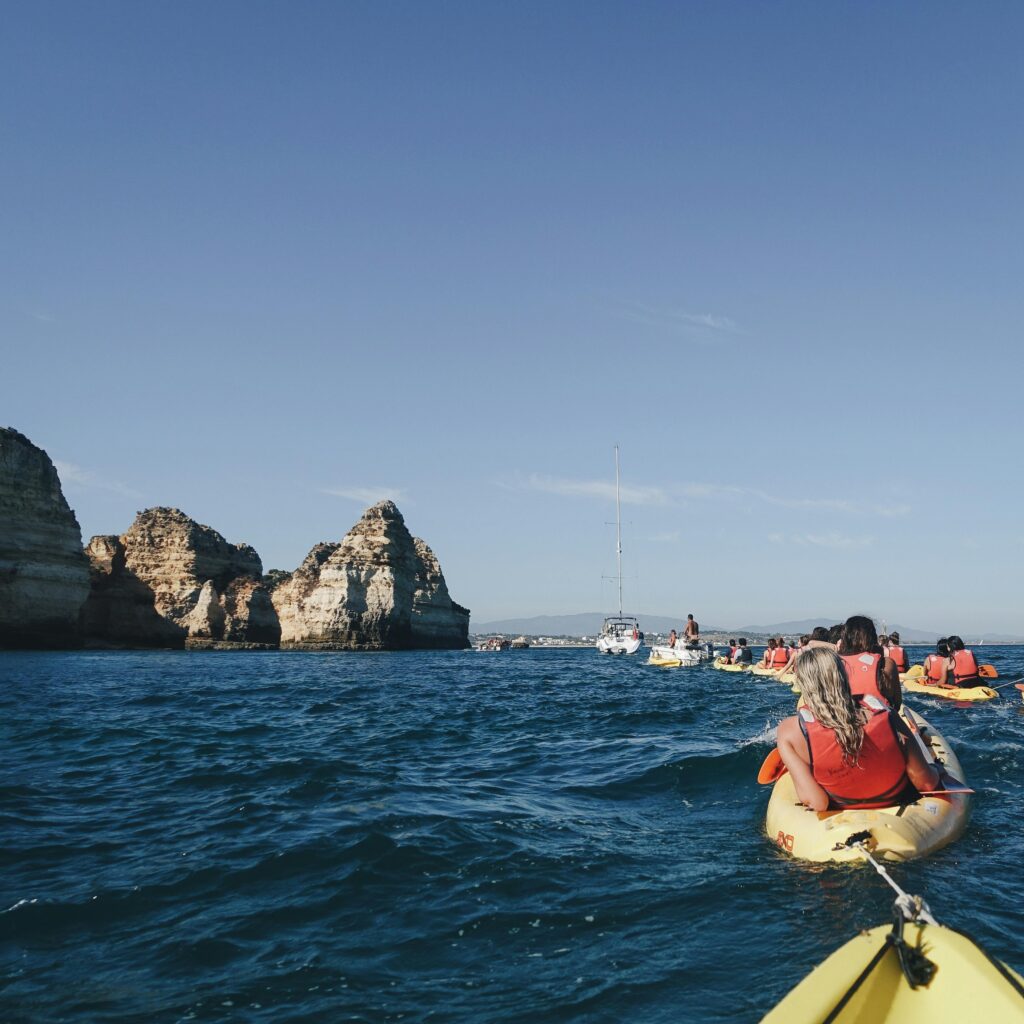Imagine this: the gentle rhythm of your paddle dipping in and out of the water, the sun warm on your face, and the salty breeze carrying the cries of seabirds. That’s the magic of sea kayaking, a thrilling form of ocean kayaking. It’s a chance to escape the everyday, to tap into a sense of adventure that’s been around for centuries.
Sure, those first kayak journeys might not take you to the Arctic, but the thrill of discovery is just as real. You’ll see your favorite shoreline from a whole new angle, maybe even spot a seal sunbathing on the rocks!
Ready to dive in? Let’s get you equipped and out on the water – your sea kayaking adventure awaits!
KEY TAKEAWAYS
- Equip with a streamlined sea kayak, appropriate paddle, and safety gear like life jackets
- Learn basic strokes, launching techniques, and balance to effectively manoeuvre the kayak
- Stay within skill limits, understand sea conditions, and always kayak with a partner
The Perfect Gear: What You Need for Sea Kayaking

Sea Kayak vs. Other Kayaks: Choosing the Right One
When it comes to kayaking, not all boats are created equal. While recreational kayaks might be perfect for a leisurely paddle around the lake, venturing into the open ocean requires a specialized vessel built for the unique challenges of the sea.
Sea kayaks, a type of kayak specifically made for paddling in the sea, are designed with a sleek, narrow hull that allows them to slice through waves and currents with ease. Which would make your long-distance journeys a breeze.
Unlike their wider, more stable cousins, sea kayaks feature a pronounced rocker that enables them to ride over swells and chop without getting bogged down.
But it’s not just about hydrodynamics – sea kayaks are equipped with airtight compartments that keep them buoyant in the event of a capsize. Furthermore, most models come fitted with either a rudder or a retractable skeg to aid in tracking and maneuverability.
These features, combined with their ample storage space and comfortable sit-inside design, make sea kayaks the vessel of choice for intrepid paddlers seeking to explore the coastlines and open waters of the world.
Essential Gear for Your First Trip
Choosing the Right Kayak and Paddle
The most essential pieces of gear for your first sea kayaking trip are, naturally, a kayak and paddle. However, selecting the perfect ones can be trickier than it seems.
- Kayak: Look for a sit-inside sea kayak designed for coastal waters. Length and width will impact speed, maneuverability, and stability. Longer, narrower kayaks track better but are less stable.
- Paddle: Don’t underestimate the importance of a quality paddle. Consider:
- Blade Material: Plastic (affordable but heavier), fiberglass (lighter), or carbon fiber (premium lightweight)
- Blade Size/Shape: Larger blades provide more power, smaller blades are more maneuverable
- Paddle Length: Properly sized for your height and kayak width
Critical Safety Gear
Proper safety equipment is non-negotiable, especially on the open water:
- Life jacket (Personal Flotation Device): A snug, comfortable fit is crucial for safety while kayaking in the ocean.
- Helmet: Protects against head injuries from impacts
- Spray skirt: A crucial piece of gear that attaches to your kayak’s cockpit rim to prevent water entry from waves.
- Dry Bags/Boxes: Keeps spare clothing, electronics, etc. dry
- First Aid Kit
- Other: Whistle, flashlight, VHF radio
Clothing for Comfort and Safety
What you wear kayaking is just as vital as your other gear:
- Cold Water: Wetsuit or drysuit, thermal layers, neoprene boots, waterproof jacket
- Warm Water: Quick-drying fabrics, hat, sunglasses, sunscreen
- Spare dry clothes for before/after paddling
Don’t cut corners when outfitting yourself for your first sea kayaking adventure. The right gear will keep you safe, dry, and fully prepared to take on the open waters.
Don’t Forget: Comfort and Convenience Items
As a beginner sea kayaker, you’ll want to focus on the essentials for comfort and convenience on your first few trips.
Pack an insulated water bottle to stay hydrated, along with compact, high-calorie snacks like energy bars or trail mix to maintain your energy levels.
Sun protection is vital, so bring polarized sunglasses to reduce glare, a wide-brimmed hat, and plenty of sunscreen.
Be sure to have a dry change of clothes for after paddling, whether it’s quick-drying shirt and shorts or warm insulating layers for cooler conditions.
Basic accessories like paddling gloves to prevent blisters and a waterproof dry bag to stash extra clothing and electronics can also enhance your comfort.
Keep things simple when starting out – as you gain experience, you can add gear suited to longer trips or specific conditions. But these basic items will cover your fundamental comfort and convenience needs as a newbie kayaker on the water.
Master the Basics: Your First Time on the Water

Launching and Landing Made Easy
As an eager beginner, I still vividly remember the mixture of excitement and trepidation I felt on my first sea kayaking launch. Take a deep breath and follow these simple steps to get started smoothly.
First, assess the wind and waves – an offshore breeze will make paddling out trickier, so watch for telltale signs like flapping flags or rougher waters farther out.
When you’re ready, place your kayak in the shallows facing the open water, just deep enough for the bow to float freely. Hop in, make sure your rudder (if equipped) is up, and use your paddle to push off from the shore.
As you clear the surf zone where waves are breaking, rotate to face them head-on, gain a bit of momentum, and power through while keeping your paddle firmly planted for stability.
The Power of the Forward Stroke
With the hardest part behind you, it’s time to settle into a rhythm and start making your way across the water. Grip your paddle lightly but securely, and immerse the entire blade fully with each stroke for maximum power and efficiency.
And here’s a pro tip: keep your arms straight and let your torso twist naturally from the hips to really put some muscle behind those strokes. It may feel awkward at first, but this torso rotation will quickly become second nature.
Turning and Maneuvering: Become a Steering Pro
Don’t be intimidated if your kayak seems to have a mind of its own at the start – steering takes practice. However, a few key techniques will have you carving turns and zipping through channels like a pro.
For wider sweeping turns, try extending your forward stroke out to the side you want to turn towards. Tighter pivot turns require switching to reverse strokes on the opposite side. And if you find yourself being blown off-course, a couple of stern rudder strokes can easily straighten you out.
Staying Upright: Tips to Avoid Capsizing
While capsizing is no fun, it’s a rite of passage for all kayakers – and honestly, not as scary as it sounds if you’re prepared! The key is developing your bracing techniques using skim strokes along either side to prevent that initial tipping motion.
If you do go over, staying calm is crucial. Most sea kayaks are designed to remain buoyant, so you can attempt to re-enter from the water. But always put safety first and don’t take unnecessary risks, especially in challenging conditions.
Those are just a few pointers to get you started confidently on the water. With patience and practice, paddling through rolling swells will start feeling like second nature before you know it!
Is Sea Kayaking for You? The Joys and Challenges
The Thrill of Sea Exploration
There’s an undeniable allure to gliding across the open waters, powered only by your own effort as you dip your paddle into the briny deep.
For the adventurous spirit, sea kayaking offers the ultimate opportunity to explore remote coastlines. You will discover hidden coves, and come face-to-face with incredible marine life in their natural habitat.
Each journey is a chance to escape the crowds and experience a profound connection with the power and serenity of the ocean.
The Physical Challenge and Reward
Make no mistake – sea kayaking demands physicality and stamina. But that’s part of what makes it so immensely rewarding.
As you dig in with every stroke, you’ll feel your muscles engage from your core down to your forearms. The gentle rocking of the swell becomes a full-body workout. And simultaneously you’ll be building strength, flexibility, and cardiovascular fitness. Not to mention the calories you will burn!
And after hours of paddling, there’s no better feeling than the well-earned weariness that comes from challenging yourself in the Great Outdoors.
Safety First: Understanding Potential Risks
Like any adventure sport, sea kayaking carries certain inherent risks that must be taken seriously. Sudden weather changes, underwater hazards, and open water all pose potential dangers.
However, many of these risks can be mitigated through proper preparation, gear, and training. Always paddle within your abilities, wear all essential safety equipment, and never venture out alone, especially as a beginner.
Take lessons to learn self-rescue techniques like bracing and re-entry. And most importantly, remain vigilant about conditions at all times.
While a healthy respect for the ocean’s power is paramount, don’t let fear hold you back from this incredible sport.
With the right precautions, you can safely experience the unparalleled joy and freedom of sea kayaking while acquiring a valuable new set of skills. Embrace the challenge, and you’ll be rewarded with memories to last a lifetime.
Where to Go: Amazing Sea Kayaking Spots for Beginners

Calm Bays and Sheltered Coves: Ideal Starting Points
When you’re just finding your sea legs, it’s best to stick to relatively calm, protected waters until you build experience and confidence.
Sheltered bays and coves make ideal nurseries for beginners, offering a chance to practice skills like launching, landing, and maneuvering without contending with heavy chop or strong currents.
The U.S. and Canadian West Coasts are famous for these types of novice-friendly locales hidden among their rugged shorelines.
Easy Rivers Meet the Sea: Perfect for Practice
Another great option for getting comfortable on the water is exploring where gentle rivers and their surrounding marshes meet the sea.
Here you can get a taste of mild tidal movements and develop experience reading currents. All while staying close to shore.
Popular spots include rivers emptying into the Chesapeake Bay, the Intracoastal Waterways of the Southeast U.S., and coastal estuaries throughout New England.
Guided Tours: Learn from the Experts
Of course, the easiest way to start kayaking safely is by signing up for a guided tour or instruction course in your local area.
Having an experienced guide along provides invaluable expertise on everything from paddling techniques and navigation to wildlife viewing and safety protocols.
Guided tours also grant access to amazing destinations you may not be able to or want to explore solo just yet. Let the pros show you the ropes while you take in incredible scenery!
No matter which option you choose, the most important things are selecting beginner-friendly waters, being well-prepared with the right gear and knowledge, and not biting off more than you can chew. Start smart to build skills and experience steadily for bigger adventures ahead.
FAQ
What is a sea kayak?
A sea kayak is specially designed for paddling in the open waters of the ocean. It is typically longer and narrower than recreational kayaks, equipped with features like airtight compartments and rudders or skegs for improved stability and maneuverability in ocean conditions.
How hard is sea kayaking?
Sea kayaking can be challenging due to the need for physical strength and the ability to handle various marine conditions. However, with proper training and starting in calm waters, beginners can gradually build their skills.
Are sea kayaks stable?
Sea kayaks are built to be more stable in open water conditions, featuring a design that can handle waves and currents better than other types of kayaks.
Can inflatable kayaks be used in the sea?
Inflatable kayaks can be used in the sea, but they are generally less suitable for rough conditions compared to hardshell sea kayaks. It is essential to choose a high-quality inflatable designed for ocean use.
Can you kayak in the sea?
Yes, kayaking can be done in the sea with the appropriate type of kayak and safety precautions. It is crucial to be aware of weather conditions and ocean currents.
Can you use a sea kayak on a lake or river?
Yes, a sea kayak can be used on a lake or river. Its design allows it to perform well in various water bodies, though it is optimized for ocean conditions.
How far can you travel in a sea kayak?
The distance you can travel in a sea kayak varies based on your skill level, conditions, and kayak type. Experienced kayakers can travel over 20 miles in a day under favorable conditions.
How fast does a sea kayak go?
The speed of a sea kayak depends on the paddler’s strength and the water conditions, but on average, a paddler can maintain about 3 to 5 miles per hour.
What to do if you capsize in a sea kayak?
If you capsize, stay calm, hold onto your kayak, and perform a self-rescue if you are trained and conditions allow. Always wear a life jacket to increase your safety in such situations.
What do you wear to sea kayaking?
Wear a wetsuit or drysuit in cold conditions, along with a life jacket. In warmer conditions, choose quick-drying fabrics and sun protection. Always prepare for the possibility of getting wet.

